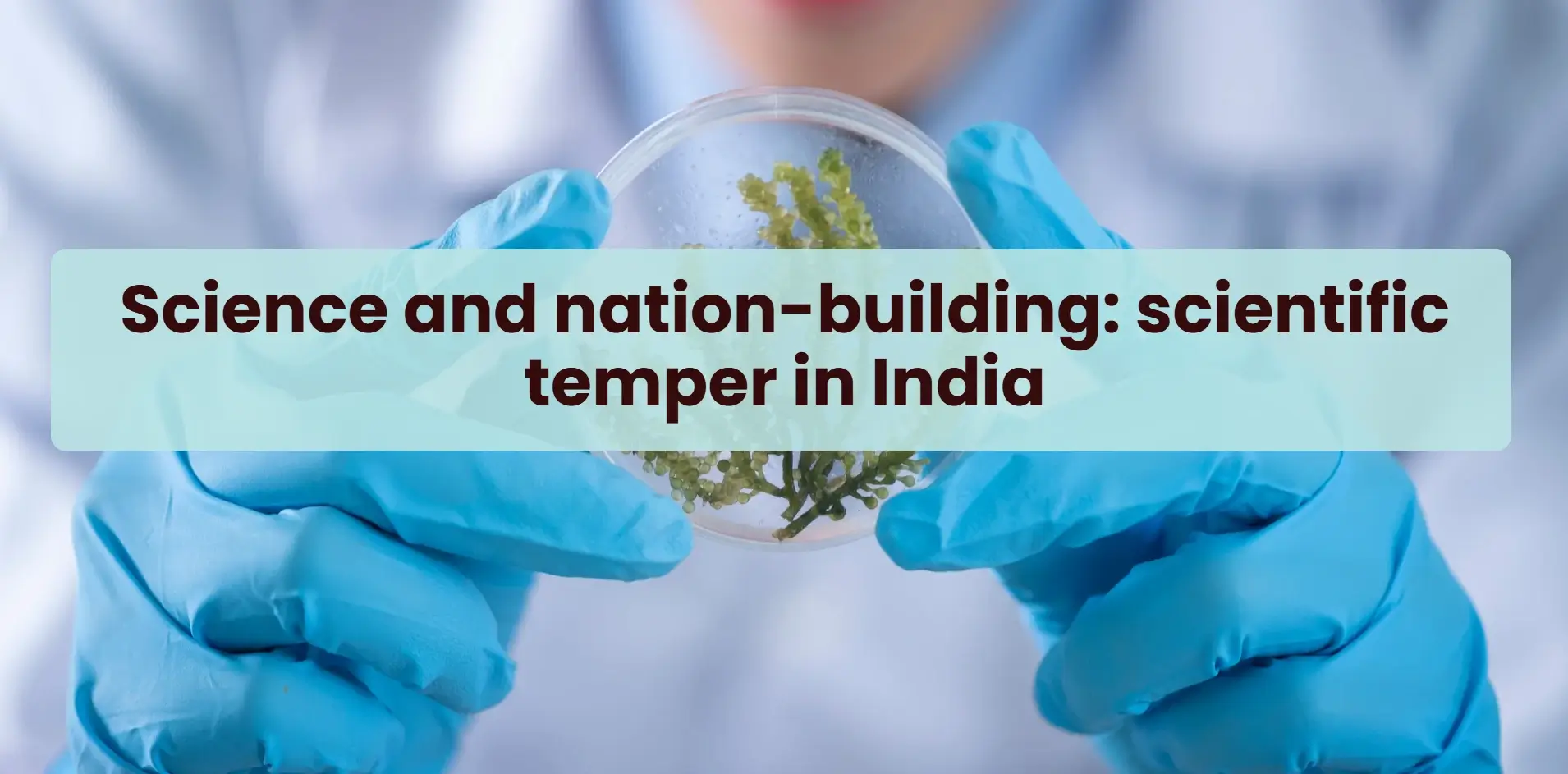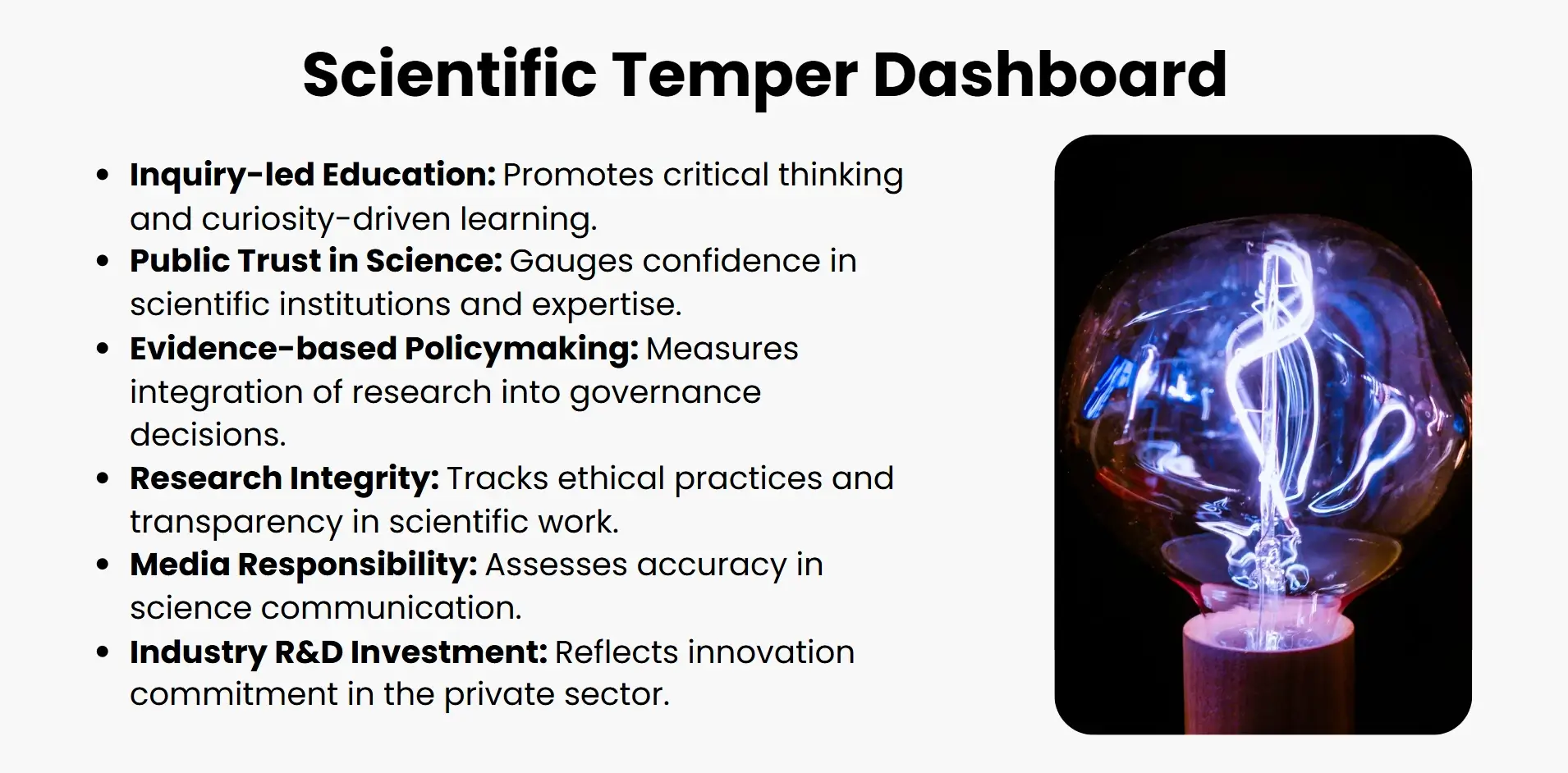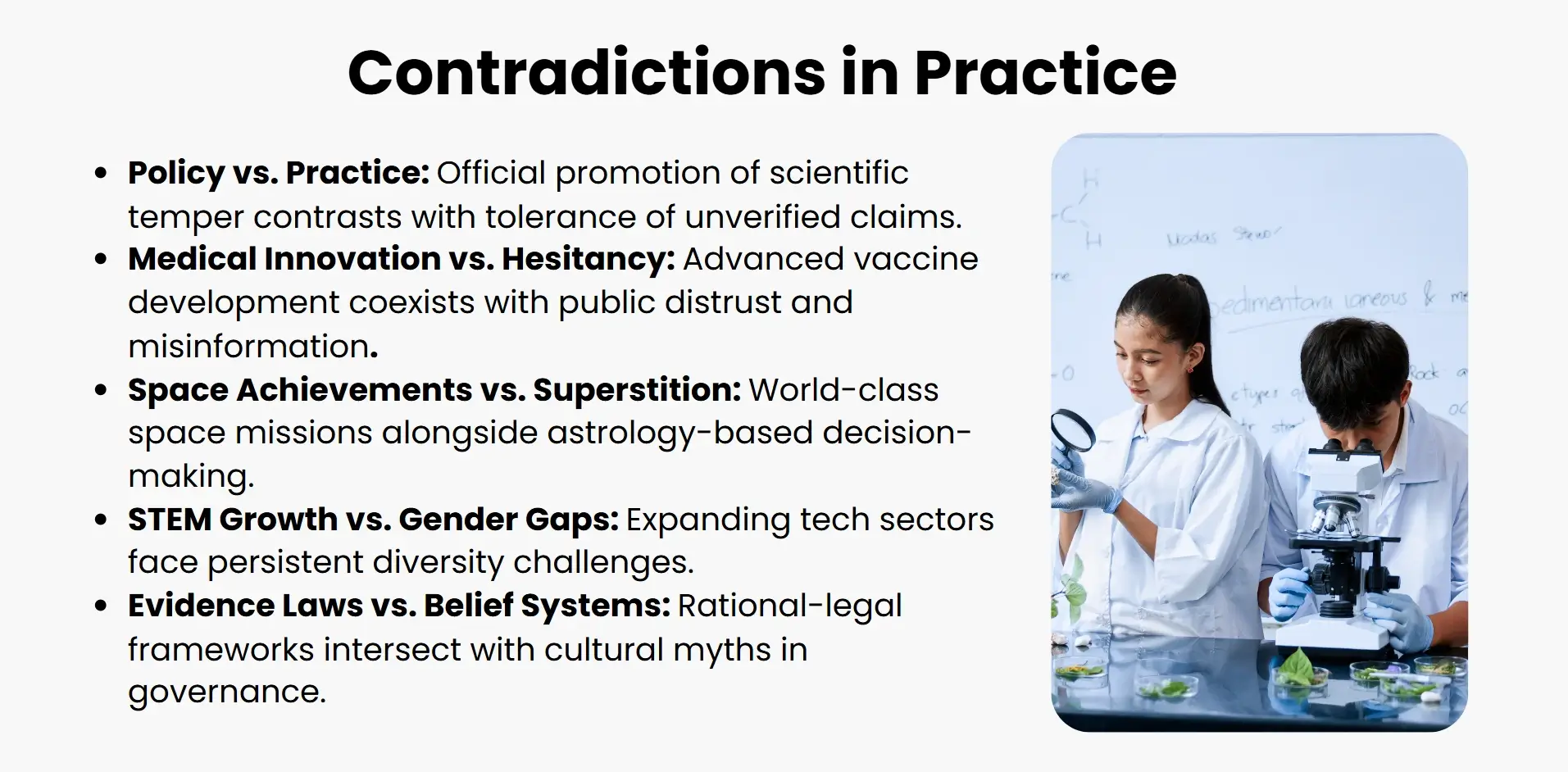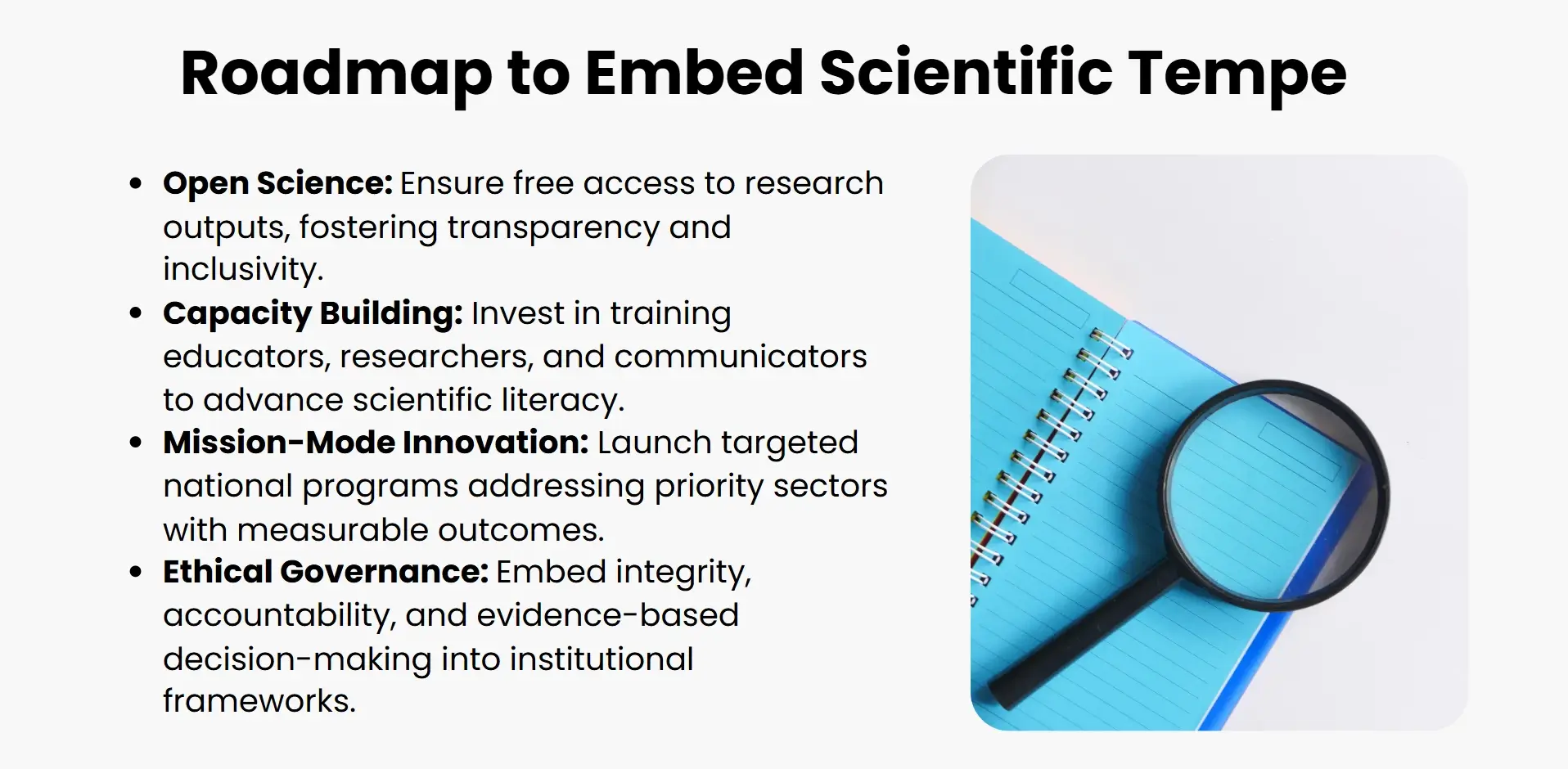The article reviews the scientific accomplishments of India, compares them with the socio-psychological attitude, and also suggests changes that can institutionalize scientific thinking and temperament in the national life.

The history of India since its independencehas been strongly linked to progress in the field of science and technology. Based on the visions of Jawaharlal Nehru and other founding leaders, the concept of scientific temper did not merely involve labs or machine-rooms; it was a civic virtue. Promotion of scientific temper was itself a fundamental duty enshrined in the Constitution, which was based on the very view that nation-building would place an emphasis both on technological advances and on a rational citizenry.The country has registered remarkable success over the decades- launches of satellites that propelled the country into the world view, farming innovations that have ended protracted food challenges, the development of indigenous vaccines that save millions of people, and digitalizing their public infrastructure, which has transformed governance and inclusion. But in addition to these successes, quotidian life in India continues to show contradictions between modern scientific advancement and the notion of superstition, unsubstantiated speculations, and pseudo-science in society.This Article explores such a paradox- cheering on the science achievements of India, coupled with rightly posing the question of whether, in fact, there is that sense of spirit of rational inquiry that was supposed to be the guiding force of the discourse and decision-making when it comes to policy and social behaviour considered upon the foundation of the country. It also suggests ways and means,structural, cultural and educational ones by which we may bring our great technical potential into parallel with the great potential of a scientifically-minded culture.
Roots of vision and policy Lineage
Scientific temper in India did not start as policy but first a moral idea. It is necessary to consider its origins to understand how institutions, education and even everyday life in a society were constructed around nation-building agendas over many decades and generations.
Constitutional ethos
Scientific temper is imbibed in the Constitution not as a technocratic decision but as a citizen value. It is framed as an essential responsibility under Article 51A(h) by developing scientific temper, humanism and spirit of inquiry that gives an indication that rationality must inform what people need to reason, how they must conduct themselveson a daily basis and how institutions must operate. This constitutional shift had written into law a larger postcolonial project: to jettison inherited hierarchies of belief and replace them with practices of inquiry, of evidence, and ofproof subject to change in the drive towards a modern and democratic republic.
Nehruvian imagination and institution-building
The nation-buildingis treated as sovereignty in action. Leaders associated labs with freedom: industrial research councils, control of atomic energy, technologies institutes, and a broad space program were meant to achieve self-sufficiency, international esteem and developmental capacity. Scientific investigation was linked to the realm of public goods, agriculture, health, water, and infrastructure by planning in a way that the process of science (as much as results) influenced administrative problem-solving and social reform.

Decades of policy consolidation
Scientific Policy Resolution (1958) explored science as a process of growth and well-being; Technology Policy Statement (1983) focused on the domestic capacity and self-sustaining. Later frameworks like Science and Technology Policy (2003), Science, Technology and Innovation policy (2013), and the proposed STIP (2020/21) took on an increasingly focused approach to innovation systems, open science and mission-mode approaches. This tradition would be continued into pedagogy, as the National Education Policy (2020) recommended inquiry-based learning and such an advisor of the National Research Foundation to spread research culture.
Changes, transitions and the gap in practice
The policy arc in India shifted as the state-owned laboratory, heavy-industry ambitions shifted to ecosystem approaches: public-private missions, digital public infrastructure and grand challenges. A fundamental contradiction nevertheless remains. Although policy does repeat scientific temper, there is an inconsistency in translating policy into classrooms, media norms and regulatory routines. The genealogy therefore also shows twofold tasks: maintaining a frontier in science, and institutionalizing the ordinary techniques of exposing the inside and judging and falsifying rationally, which has made such inquiry a social convention.
Signposts that defined Indian science and technology phenomena
Study of India's science and technology experience is based on dynamism of vision, resilience and strategic investment. Important milestones are displayed on how institutions, missions, and policies were transformed according to the aspirations of the country.
Institution-building in the post-independence era
Scientific infrastructure started in the 1950s and 1960s. The beginning of the Council of Scientific and Industrial Research (CSIR), Indian Institutes of Technology (IITs), and Atomic Energy Commission was a decisive move towards self-reliance. These schools were not only universities; they were boilers of industrial modernization, defense capacity and technical sovereignty. Irrigation technology and agricultural research fuelled the Green Revolution (1960s-70s), which changed the face of food security and livelihoods.
Strategic mission and international credibility
The launch of India in the space and nuclear sectors changed the position of India in the field of science globally. Indian Space Research Organisation ISRO established in 1969 built Aryabhata (1975), INSAT (1983) and subsequently Chandrayaan and Mangalyaan missions with frugal innovation, mission-mode and flexibility. Pokhran printed indigenous competency in a high-stakes science. The goals combined scientific and geopolitical yen.
Liberalization and innovation system
After the LPG reformsprivate sector saw major role in R&D. The emergence of Information Technology and Biotechnology related industries with Software Technology Parks and Department of Biotechnology as supportive pillars (1986) established India as an international technology-warehouse. During the 2000s nanotechnology missions, digital governance platforms and public-private partnerships in the pharmaceutical and renewable energy sectors developed. Tech-led inclusion merges tech and scale, as in the case of the Aadhaar project (2009 onwards), which combined the power of biometrics with scalability of the infrastructure.
Modern changes and promises of tomorrow
Newer developments are the National Quantum Mission(2023), deep-tech startup accelerators, and AI ethics frameworks. The leadership of India in the development of vaccines against COVID-19 and building open science and digital public goods points to a new era, in which science is about not only excellence, but also equity, ethics and international cooperation.
Do we act in scientific temper?
Scientific temper is not equally applied throughout Indiain spite of constitutional and policy promises. Such technological adoption is common but rational inquiry and evidence-based thinking has not become the norm of the society.
Constitution Ideal vs. reality
Scientific temper is developed as a fundamental dutyas mentioned in the Indian constitution. Nehru had viewed it as a lifestyle- a lifestyle where thought was critical, evidence could be tolerated and dogma would never be tolerated. However, such ethos is usually idealistic. Although science has changed infrastructure, health and communication, irrational beliefs have remained to apply on the state policies and they give way to that which is not scientific at all which is so calledpseudoscientific claims.
Learning and popular awareness
India education system has progressed regarding the expansion of STEM but the inquiry-based learning process remains very scarce. There is rote learning in the classrooms and scientific reasoning is not developed as a civic skill. The National Education Policy (2020) is expected to change this paradigm and make it curious and critical thinkers. Nonetheless, there remain weak points in implementation particularly in rural and under-financed schools. One issue of science communication in the public realm even rears its ugly head: reach and credibility are difficult feats in the competition against misinformation and superstition.
Pseudoscience, politics, media
The media is rife with pseudoscientific assertions ranging in seriousness (at least in the claims they present them) to astrological prediction and miracle cures. Such cultural myths as cow urine cures cancer have been supported by political leaders. These kinds of statements diminish the confidence in scientific institutions and obscure the distinction between cultural pride, fact, and evidence. Scientific rigor has been compromised at even well-known forums, such as an Indian Science Congress in which there were a few instances of fringe claims.
Health behaviour and vaccine hesitancy
The pandemic in 2019 cited scientific temper’s strength and weakness. The development and rollout of the vaccine in India had been internationally recognized, but suspicion and misinformation (being the cause of the vaccine hesitancy) has brought about the lacking in the public confidence and scientific literacy. Although there is a massive penetration of mobile phones and other digital technologies, numerous citizens still do not trust scientific explanations but prefer to rely on anecdotal or community beliefs.
Grassroots and lower rationalism
Positively, rationalists’ movements and science teachers still attack the superstition and empower the evidence-based decision-making. Grassroot movements against blind faith and pseudoscience have been initiated by non-state organizations. These initiatives demonstrate that scientific temper may be developed bottom-up as opposed to being implanted.

Contradictions, limitations, and comparative sense
India has undertaken an ambitious and successful path of science and technology, but with contradictions and limits as well. The comparative perspective allows identifying the systemic constraints and a chance to change.
Internal contradictions in policy and practice
The Indian policy rhetoric is highly in favour of scientific temper and innovation but there are discrepancies between the claimed objectives and reality on the ground. As an example, although the National Education Policy (2020) encourages the implementation of inquiry-based learning, classroom learning is still filled with rote learning. In the same way, government missions tend to concentrate on evidence-based decision-making, nevertheless, pseudoscientific propositions are likely politically to be endorsed. Such tensions indicate a disjuncture between institutional ideal and societal absorption in which science is cheered, although not necessarily followed strictly.
Innovation bugbears at the structural level
There are a number of structural limitations toward scientific development in India. The poor public investment in research (at less than 1 percent of GDP), bureaucratic barriers and incomplete innovation ecosystems undermine long-term scientific research. Adding further to disparities is talent exodus and unequal access to research infrastructure. In addition, regulatory barriers, interdisciplinary collaboration are hampered, and the process of transforming research into stageable solutions becomes sluggish. These restrictions are not only found in India but are enhanced by its size and its diversity.
Global models as comparative knowledge
Other useful contrasts exist in the country of South Korea, Israel, and Germany. The systemic R and D investments and education reforms in South Korea led to an effective innovation economy. Military-academic connections and nimble regulation form Israel startup ecosystem. The German education system of dual education and industrial research networks leads to high integration of science with the society. The problem in India is how to modify these models to our federalist parameters, our sheer size of population and our socio-economic diversity.

A practical roadmap
Scientific future in India requires an inclusive, evidence-based and mission-oriented roadmap in science and technology. This plan should close the gap between policy aspirations and ground action and international cooperation.
Transformation strategic pillars
Four pillars that lie behind an understandable roadmap include:
- Open science ecosystems that democratize access to research and data;
- Capacity building by using inquiry-based education and interdisciplinary training;
- Mission-mode innovation to focus on climate resilience, health equity, and digital infrastructure; and
- Ethical governance so these are transparent, accountable, and trustworthy to science.
Implementation pathways
In order to bring this vision to practice, India has to invest in regional research centres, encourage the partnership between the public and private sectors, and simplify the regulatory system. Knowledge diffusion can be enhanced with the help of digital tools such as the AnusandhanNational Research Foundation and open-access repositories that can hasten the process. Community science projects, consumer participation and vernacular science dissemination will democratize scientific temper to being a way of life, not a privilege of elites.
Conclusion
The Indian experience with science and technology is one that complements both dreamlike vision and the consistent lack. The country has established fierce institutions and capacities in constitutional ideals up to global missions. Still, scientific temper, as an approach that should shape daily logic and moral thinking by society, is haphazardly conducted. Identity politics (irreconcilable differences between policy and practice), the tangles of institutional structure, and the general societal rejection of rational inquiry all continue to impede movement. Comparative lens sheds light upon the possibility of reform taking place, though it should be placed within the context. The way ahead is to build a culturally appreciativeculture of asking questions, making a commitment to inclusive education, and incorporating ethics and evidence in governance. Science should not only be at the service of innovation but it should also strengthen democratic values. Scientific temper within a constitutional framework can be converted to a cultural ethic through a pragmatic plan of action, which will be based on the foundation of open access, collaborative approach to all fields of study and citizen participation. The future of India does not merely rely on the excellence of science, but on how rational inquiry becomes a civil productive activity at various institutions, classrooms and in communities.